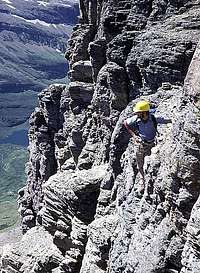-
 45975 Hits
45975 Hits
-
 86.85% Score
86.85% Score
-
 23 Votes
23 Votes
Introduction
This is a brief overview. It is very strongly recommended that anyone planning to do much climbing in Glacier Park obtain a copy of:
A CLIMBER'S GUIDE TO GLACIER NATIONAL PARK, by J. Gordon Edwards.
This book not only describes climbing routes, but also many fine high routes in the Park that do not involve summits. In addition there is much history and other information making visiting and climbing in the Park more enjoyable.
Because the rock in Glacier National Park is extremely poor by rock climbing standards, classical rock climbing ratings do not really apply in most places. Thus Edwards and the Glacier Mountaineering Society have developed their own grading systems dealing specifically with the Park.
ROCK
Nearly all the rock in Glacier Park is sedimentary and by rock climbing standards would be described as "bad" by almost anyone. Places do exist where technical climbing is possible on fairly sound rock, but they are rare.
Rock types encountered on most peaks are thin-bedded, brittle limestone and thin-bedded, brittle argillite. There are occasional thicker bedded layers creating larger cliffs. These bedded rocks tend to weather into cliffs alternating with sloping ledges giving peaks a "layer cake" appearance where the beds are flat-lying.
CLIMBING CONSIDERATIONS
Mountain climbing is recognized as an acceptable activity in Glacier National Park (it has to be under the law), however, the National Park Service presently designates the activity as "not encouraged" for many of the reasons stated in this section.
Most of the rock is brittle, so thin holds tend to break easily. It is also generally very loose. Sometimes handholds are used that will sustain a downward pull, but come out easily if pulled horizontally.
Nearly all ledges are covered to some extent by loose talus or scree. This is not always visible from below. Standing on a two foot wide ledge covered by down sloping loose scree can be every bit as dangerous as standing on a quarter inch down sloping hold on good granite - but in Glacier, people tend to wander about on narrow ledges unroped.
Climber caused rock fall is a major concern.
Many routes make long traverses on prominent ledges. And most routes have numerous variations possible as one finds their way up through the series of ledges and cliffs traversing left or right looking for the easiest or most convenient way to the next level.
There are two major rating systems being used in the Park. One in the climbing guide and one devised by the Glacier Mountaineering Society.
RATING SYSTEMS
EDWARDS RATING SYSTEM
Because of the unique nature of the rock and the dangers involved, the climbing guide uses a rating system that involves relative danger as much as technical difficulty.
Class 1. Very easy. Doable by nearly anyone in condition and with good footgear. There is no rock climbing involved.
Class 2. Easy. A few rock ledges, but nothing dangerous in good weather.
Class 3. Moderate. Small cliffs that may be difficult and steep scree requiring exertion. Little danger of physical injury if careful.
Class 4. Difficult. Ascends rock where a fall could be quite serious. The technical difficulty is not necessarily hard, but the potential hazard is significant. Rock climbing experience is needed and belaying is recommended.
Class 5. Severe. Points of protection might be needed and belaying is essential. A fall certainly serious.
Class 6. Very Severe. Aid climbing. Experience in placements in sedimentary rock needed.
GLACIER MOUNTAINEERING SOCIETY SYSTEM
The Glacier Mountaineering Society developed its own rating system expanding on that used by Edwards in the guidebook.
The first number in Roman Numerals is the overall rating of the climb and the Arabic number in parenthesis is the difficulty of the most difficult pitch.
Note that the words used to describe Class 1, 2, 3, and 4 differ between the two systems. The GMS calls each of these classes a little more difficult than Edwards.
HOWEVER, it is important to note that a comparison of the ratings given by Edwards and those by the GMS shows that the numbers remain the same. In other words a GMS Class III(3) is the same as an Edwards Class 3. A GMS Class III(4) is generally described by Edwards as Class 3 with one (or more) places of Class 4.
Class I (1) Easy: Trail hiking.
Class II (2) ) Moderate: Low angle scrambling.
Class III (3) ) Difficult: High angle scrambling, moderate cliffs, considerable exertion. A rope might be necessary for beginners.
Class IV (4) ) Very Difficult: Higher angle cliffs, increased exposure. Rope required for belaying.
Class V (5) ) Severe: High angle cliffs with severe exposure. Protection placed by leader. Technical climbing experience is necessary.
Class VI (6) ) Extremely Severe: Direct aid technical climbing. Overall rating in this classification reserved for only the biggest technical climbs such as the North Face of Mount Siyeh or the East Face of Mount Gould.
The GMS system also includes letter codes for distance and elevation gain. Descriptions of these codes can be found on the GMS page:









